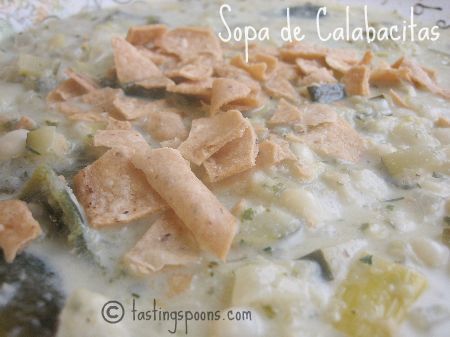
Oh, yum. Oh yes, another winner of a soup. I think the recipe came from Gourmet Magazine, but am not sure, since I made no note on the clipping. (These food mags change their format so frequently lately that I no longer recognize the arrangements or layouts anymore.) I wasn’t able to find it online, so can’t confirm, however the paragraph with it says the origin of the recipe is Estela Salas Silva who runs a Mexican cooking school in Puebla, Mexico. If you search for her name online, you’ll find mention of her in several places.
One of my very favorite vegetable combos is Southwestern Calabacitas. I wrote up a post about it last year. I like it so much I could easily make it my entire dinner. So when this recipe went across my radar as a soup, well, I thought, how perfect. Calabacitas (cal-a-bah-see-tas) is/are actually a Mexican squash, very similar to zucchini, but normally smaller, a bit more squat in shape, and have a more mottled green and yellow skin. But taste-wise, they’re almost the same. However, when you say “calabacitas” in Southwestern cuisine, it means a mixture of corn, the squash, probably onion and poblano chiles. They’re one of those combinations that represent a food marriage, to me anyway.
Ideally you’ll make this in the summer when zucchini and corn are in season, but surely it would be good with frozen corn, especially the frozen grilled corn sold at Trader Joe’s, for instance. You will need access to the poblano (also known as pasilla) chiles, and at least some kind of hotter type like Serrano or jalapeno. I used jalapeno because the serranos at my market didn’t look all that great.

There is a bit of chopping and mincing, but if you don’t care about the size of the chopped stuff, do it in the food processor, and it would take no time at all. I was experimenting with my new Alligator chopper. It’s immensely cool. And easy. Love this new toy (except for finding a home for it in my kitchen since it’s a tad bulky). I took a photo of it – with a small red onion inside. First you peel the onion and I only put in a half an onion at a time, but with the slam of the chopper you have a bunch of perfectly chopped vegies. I’ve used it for onions, small celery stalks, squash, shallots, garlic, peeled fresh tomatoes, radishes, bell peppers and apples. As you chop, the chopped stuff goes up into the clear plastic box on the top. Once you’re done, or it’s full, you turn the whole thing over and flick the box off and empty the container into your pot, or salad, or whatever. In case you wonder – why do you need one of these? If you want perfectly cut minced squares of things, this is it. As wonderful as a food processor is, it doesn’t chop things up uniformly, which is fine in most cases, but if you want exactly 1/4 inch cubes, the Alligator is your answer.
Anyway, this is a simple soup, really: onions, zucchini, poblanos (that have been grilled, skins removed), garlic, corn, cilantro, some cream at the end, and a tad of dill. And, if you happen to have them, some squash blossoms to garnish the soup bowl. I made this full recipe – which says it serves 8 – well, maybe 8 small servings. We had it for dinner last night, and with our hungry son-in-law Todd on hand, the entire pot of soup disappeared. My DH said – please make this again. Soon. Okay by me, but I’m going to double the recipe and freeze half.
MasterCook 5 import file and MasterCook 14 import file
Sopa de Calabacitas (Mexican Zucchini & Corn Soup)
Recipe: Estela Salas Silva, and I think via Gourmet Mag.
Servings: 8
Cook’s Notes: Usually poblanos (also called pasilla) are not hot, but in some months of the year they may be warmer than usual. Likely any hotter chile will work for the Serrano or jalapeno, but this is not supposed to be a truly spicy hot vegetable. Leeks were added by me, just because I had them on hand but they’re not typical for this dish. I’d add them next time anyway. I didn’t have epazote, or squash blossoms, so used dill, and added crushed up tortilla chips on top to give the soup some added texture.
1/2 pound poblano chiles — 2 or 3
1 1/2 pounds zucchini — or calabacitas squash, cut in 3/4 inch cubes
1 cup onion — chopped
2 small leeks – chopped [not in the original recipe]
3 whole garlic cloves — minced
2 tablespoons unsalted butter
2 cups low-sodium chicken broth
2 cups water
2 cups fresh corn kernels — about 3-4 ears
3 tablespoons cilantro — or more to taste
2 tablespoons fresh dill — or epazote leaves, chopped
1 teaspoon serrano pepper — minced, or 1 jalapeno, minced, seeded
1 cup heavy cream
salt and pepper to taste — or to taste
1 cup squash blossoms — coarsely chopped, optional
1. Roast poblanos: roast on their sides on racks of gas burners, 1-2 chiles per burner, on medium-high heat (or on rack of a broiler pan 2 inches from broiler), turning frequently with tongs, until skins are blistered and lightly charred all over, 4-6 minutes (6-8 if broiling). Transfer to a large bowl, then cover with a plate and let stand 20 minutes. Peel or rub off skin. Slit poblanos lengthwise, then stem, seed and devein. Cut poblanos in 1/2 inch squares.
2. Soup: cook zucchini, onion, garlic and 1 1/2 teaspoons salt in butter in a wide 4-6 quart heavy pot over medium heat, stirring, until vegetables are softened. Add broth, water, poblanos and corn and simmer, partially covered, until corn is tender, about 5 minutes.
3. Puree 2 cups soup in a blender with cilantro, epazote (or dill) and serrano or jalapeno chile until smooth (use caution when blending hot liquids). Return to pot.
4. Stir in cream, the squash blossoms (if using, using remainder for garnish), salt and pepper to taste. Return to simmer, then serve garnished with blossoms.
Per Serving (based on eight 1-cup servings): 200 Calories; 15g Fat (60.3% calories from fat); 6g Protein; 16g Carbohydrate; 3g Dietary Fiber; 49mg Cholesterol; 29mg Sodium.









Leave a Comment!